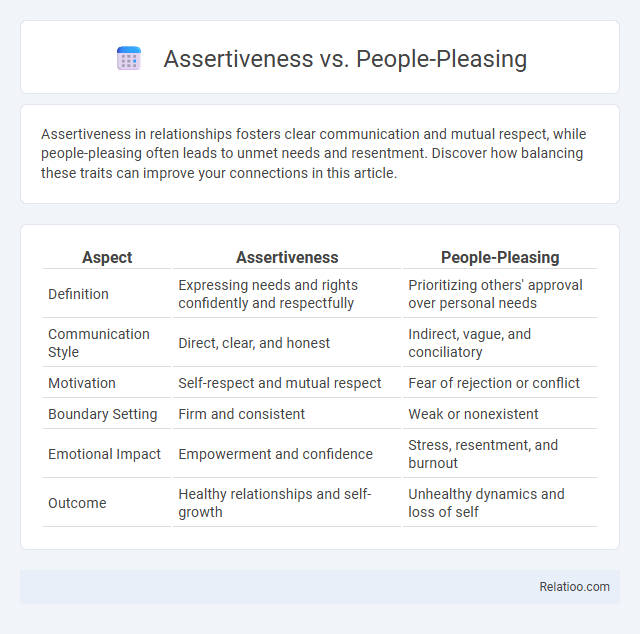Assertiveness in relationships fosters clear communication and mutual respect, while people-pleasing often leads to unmet needs and resentment. Discover how balancing these traits can improve your connections in this article.
Table of Comparison
| Aspect | Assertiveness | People-Pleasing |
|---|---|---|
| Definition | Expressing needs and rights confidently and respectfully | Prioritizing others' approval over personal needs |
| Communication Style | Direct, clear, and honest | Indirect, vague, and conciliatory |
| Motivation | Self-respect and mutual respect | Fear of rejection or conflict |
| Boundary Setting | Firm and consistent | Weak or nonexistent |
| Emotional Impact | Empowerment and confidence | Stress, resentment, and burnout |
| Outcome | Healthy relationships and self-growth | Unhealthy dynamics and loss of self |
Understanding Assertiveness and People-Pleasing
Assertiveness involves confidently expressing one's needs and boundaries while respecting others, promoting healthy communication and self-respect. People-pleasing often stems from a fear of rejection, leading individuals to prioritize others' approval at the expense of their own well-being. Understanding the distinction between assertiveness and people-pleasing helps develop balanced relationships by fostering genuine self-expression without sacrificing empathy.
Key Differences Between Assertiveness and People-Pleasing
Assertiveness involves expressing one's thoughts, feelings, and needs honestly and respectfully, maintaining clear boundaries, while people-pleasing centers on seeking external approval by prioritizing others' desires at the expense of personal well-being. Assertive individuals balance self-respect with empathy, making decisions aligned with their values, whereas people-pleasers often experience resentment or burnout from neglecting their own needs. Key differences include motivation--self-advocacy versus fear of rejection--and the ability to say no without guilt.
The Psychology Behind People-Pleasing
People-pleasing behavior often stems from a deep-rooted need for approval and fear of rejection, which can be linked to low self-esteem and anxious attachment styles. Psychological research highlights that people-pleasers prioritize others' needs to avoid conflict and gain external validation, often at the expense of their own mental health. Understanding the cognitive patterns behind this tendency is essential for developing assertiveness and breaking free from codependent dynamics.
Signs You Might Be a People-Pleaser
Signs you might be a people-pleaser include a constant need for approval, difficulty saying no, and prioritizing others' needs over your own well-being. This behavior often stems from underlying codependency, where self-worth is tied to others' validation, leading to neglect of personal boundaries. Unlike assertiveness, which promotes healthy self-expression and mutual respect, people-pleasing results in emotional exhaustion and resentment.
Benefits of Being Assertive
Being assertive empowers you to communicate your needs clearly while respecting others, fostering healthier relationships and reducing stress. Unlike people-pleasing or codependency, assertiveness promotes self-respect and personal boundaries, leading to increased confidence and decision-making skills. Practicing assertiveness enhances emotional well-being and helps achieve goals effectively without compromising your values.
Negative Consequences of People-Pleasing
People-pleasing often leads to chronic stress and diminished self-esteem as individuals suppress their own needs to gain approval. This behavior can result in unhealthy relationships where boundaries are blurred, fostering codependency and emotional exhaustion. Over time, the inability to assert oneself undermines personal growth and perpetuates feelings of resentment and burnout.
How to Develop Assertiveness Skills
Developing assertiveness skills involves recognizing and expressing your own needs and boundaries clearly while respecting others, differentiating this from people-pleasing, which often sacrifices your interests to gain approval, and codependency, which emphasizes excessive reliance on others for validation. You can practice assertiveness by using "I" statements to communicate feelings and desires directly and respectfully, setting limits without guilt, and building confidence through gradual exposure to challenging social situations. Strengthening assertiveness improves your self-esteem, fosters healthier relationships, and reduces tendencies toward people-pleasing and codependent behaviors.
Setting Healthy Boundaries in Relationships
Setting healthy boundaries in relationships involves recognizing the difference between assertiveness, people-pleasing, and codependency to protect Your emotional well-being. Assertiveness allows You to communicate needs and limits clearly without guilt, whereas people-pleasing often leads to sacrificing personal needs to gain approval, and codependency fosters unhealthy reliance on others for self-worth. Establishing clear boundaries empowers You to foster respectful, balanced relationships that promote mutual trust and self-respect.
Overcoming the Fear of Disapproval
Overcoming the fear of disapproval requires distinguishing assertiveness from people-pleasing and codependency by valuing personal boundaries over external validation. Assertiveness empowers individuals to express their needs confidently without guilt, while people-pleasing and codependency often stem from deep-seated fears of rejection and a compulsive need for approval. Developing self-awareness and practicing affirmations can reduce dependency on others' opinions, fostering healthier relationships and emotional resilience.
Steps to Transition from People-Pleasing to Assertiveness
Transitioning from people-pleasing to assertiveness involves recognizing personal boundaries and practicing clear, direct communication of needs and desires. Developing self-awareness through mindfulness techniques and journaling helps identify patterns of codependency and emotional triggers, facilitating healthier interactions. Consistently setting and maintaining limits cultivates confidence and reduces reliance on external validation, fostering emotional independence and balanced relationships.

Infographic: Assertiveness vs People-Pleasing
 relatioo.com
relatioo.com